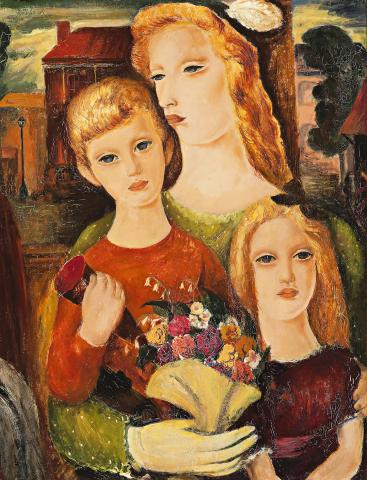WOMAN AND HER CHILDREN ON A TRAM, c.1946
CONSTANCE STOKES
oil on canvas
71.0 x 54.5 cm
signed lower right: Constance Stokes
Joseph Brown Gallery, Melbourne
Private collection, Melbourne,
acquired from the above in 1978
Sotheby’s, Melbourne, 7 May 2001, lot 7
Private collection, Tasmania
Autumn Exhibition 1978, Joseph Brown Gallery, Melbourne, April 1978, cat. 95
Constance Stokes, 1906 – 1991, National Gallery of Victoria, Melbourne, 3 March – 19 May 1993, cat. 9 (as ‘Woman & her children on a tram’, 1950s, label attached verso)
A Century of Australian Woman Artists, Deutscher Fine Art, Melbourne, 4 June – 3 July 1993, cat. 155
Clark J., Constance Stokes, National Gallery of Victoria, Melbourne, 1993, cat. 9
A Century of Australian Women Artists, Deutscher Fine Art, Melbourne, 1993, cat. 155, p. 93 (illus.)
D’Albrera, L.W., Constance Stokes: Art and Life, Hill House, Melbourne, 2015, pp. 88 (illus.)
In London in 1953, Sir Kenneth Clark hosted a celebratory lunch for four of the artists whose paintings had gone on display the night before in the New Burlington Galleries’ exhibition, Twelve Australian Artists. In the presence of co-exhibitors Russell Drysdale, William Dobell and Douglas Annand, Sir Kenneth rose to give a speech in which he declared that Stokes was ‘one of the finest draughtsmen [sic] in the world today.’1 Her fame was further boosted when the art critic for The Times publicly declared that Stokes’ painting Girl with Red Tights 2 as ‘the one picture in London you must see this week.’3 This was, and remains, spectacular praise for a wonderfully talented artist who nonetheless struggled with the demands of house and three children to give full attention to her painting.
Which is not to say she didn’t work extremely hard when she got the chance. ‘She had to paint like other people had to eat’, said her longtime colleague Dorothy Braund.4 A former student at the National Gallery School under Bernard Hall, Stokes was awarded the Travelling Scholarship in 1929 and headed to London for a year’s study at the Royal Academy. She then went to Paris to study at André Lhote’s more progressive private school, already noted for attracting as students the Australian artists Grace Crowley, Dorrit Black and Anne Dangar, in 1927. On her return in 1933, Stokes held a highly successful solo show before marrying and thus devoting the next thirty years to developing her career within the tight confines of family life.
One creative lifeline was an invitation by the renowned teacher George Bell for Stokes to join his weekly drawing class held at his home studio in Toorak. Apart from life drawing, Bell also taught his students the intricacies of glazing, and this technique, allied with her intimate study of early Renaissance paintings in London, led Stokes to develop a personal style which combined ‘the devotional quality … of idealized beauty (and a) parallel interest in modern art.’5 Woman on a Tram, c.1946 was developed from a sketch executed during her weekly tram trip to Bell’s studio, and Stokes obviously identified with the parallel status of her female subject, laden with young children en route to visit family or friends. The infinite patience of the mother is suggestive of an early Madonna whilst, outside the tram, Melbourne’s suburban landscape of terraces and street lamps sweep by. The image is anchored to an Australian location, whilst serving to enhance the artist’s suggestion that transcendent human experiences may often be found within the everyday.
1. D'Abrera, L.W., Constance Stokes: Art and Life, Hill House, Melbourne, 2015, p. 110
2. In the collection of Mulberry Hill, Victoria
3. The artist in conversation with de Berg, H., 2 December 1965, tape 170, transcript, National Gallery of Victoria Library, Melbourne, p. 5
4. Sumner, A., The Lost Mother: a story of art and love, Melbourne University Publishing, Melbourne, 2009, p. 153
5. St John Moore, F., Classical Modernism: the George Bell Circle, National Gallery of Victoria, Melbourne, 1992, p. 125
ANDREW GAYNOR
